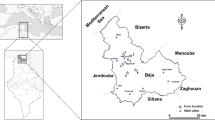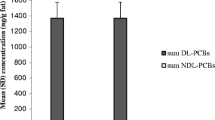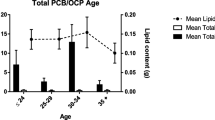Abstract
In this study, organochlorine pesticides (OCPs) and polychlorinated biphenyles (PCBs) levels were determined in 100 human milk samples from the city of Antalya. The levels of seven major PCB congeners; 28, 52, 101, 118, 138, 153, 180 and nine OCPs, α-HCH, β-HCH, γ-HCH, HCB, heptachlor epoxide, p.p′-DDT, p,p′-DDE, endosulfan-α and endosulfan-β were determined by gas chromatography with ECD detection. The levels of analyzed compounds were as follows: ΣPCBs 27.46 ± 11.58, ΣDDT 1,407 ± 123, and ΣBHC 160 ± 490 ng/g lipid wt.basis. PCB 153 and p,p′-DDE were the dominant contaminants. The results have been discussed and compared with similar studies from other regions of Turkey.
Similar content being viewed by others
Explore related subjects
Discover the latest articles, news and stories from top researchers in related subjects.Avoid common mistakes on your manuscript.
Organochlorine pesticides (OCPs) and polychlorinated biphenyles (PCBs) are considered as persistent organic pollutants (POPs) and their production and usage is banned in Turkey and many countries due to toxicity, persistence, mobility and bioaccumulation in the environment in accordance with The Stockholm Convention. OCPs and PCBs are persistent in the environment, and their high lipophilicity results in their bioconcentration into the biota and biomagnification through the food chain (Bolt and Degen 2002; Safe 1994). Consequently, these compounds when released into the atmosphere can travel long distances before they are deposited onto water, soil and vegetation, causing a widespread occurrence of such compounds. In humans a wide variety of health effects have been linked to high exposure to OCPs and PCBs, including developmental defects, reproductive effects and chloracne, hormonal dysfunctions, reduced mental performance, endometriosis and cancer (Safe 1994; Guo et al. 2000). Especially during the last two decades, it has been hypothesized that various human male reproductive disorders, such as testicular germ cell cancer, cryptorchidism, hypospadias and low sperm counts, have a common aetiology and may be related to increased OCPs and PCBs exposure in utero or in early human life (Sharpe 2003).
In Turkey, OCPs were used widely in large quantities in agricultural activities between 1945 and 1985. The usage of PCBs was restricted and banned after 1996 in Turkey. OCP residues have been monitored in breast milk of the Turkish population by conducting regional surveys investigating the issue since 1976 (Cetinkaya et al. 1983; Karakaya et al. 1987; Kelle 1989; Üstünbaş et al. 1994; Çok et al. 1997, 2004, 2005; Erdoğrul et al. 2004). However, results obtained from only 10 different provinces have been available until today with both mother’s milk and adipose tissue. On the other hand there are very few papers providing evidence of human exposure by reporting PCB contamination levels in human milk from Turkey (Çok et al. 2003; Çok and Şatıroğlu 2004; Erdoğrul et al. 2004). Therefore, the values for Antalya province obtained in this study will play a critical role in determining the general contamination of OCPs and PCBs and are considered important in terms of providing baseline data from a different source of OCP and PCB contamination in Turkey.
Materials and Methods
Between September 2007 and April 2008, 100 human milk samples were taken from the Akdeniz University, School of Medicine, Department of Obstetrics and Gynecology, from different nursing mothers living in the Antalya area for at least 5 years. Milk samples (15–30 ml) were taken from one of the breasts by manual expression at the end of the feeding, and between the 5th and 40th day of postpartum. They were kept frozen at −20°C until analysis. The mean age was 28.5 ± 5.2. We followed the code of ethics established by the Helsinki Declarations of 1964 and revised in 2000. Each participant provided informed consent after receiving a detailed explanation of the study and potential consequences and signed an informed consent form. The mothers were mixed food consumers, most of them, except seventeen, were non-smokers, and 50 had one, 42 two children and 8 were multiparous (more than 3).
Human breast milk samples were extracted according to the method by Krauthacker et al. (1991). Gas chromatographic (GC) analysis was performed using a Hewlett-Packard Model 5890 Gas chromatograph equipped with a 63 Ni electron capture detector (ECD). Nine OCPs; HCB, α-HCH, β-HCH, γ-HCH, p.p′.DDE, p.p′.DDT, heptachlor epoxide, endosulfan-α, endosulfan-β and seven PCB congeners (PCB# 28,52,101,118,138,153 and 180) were quantified. All samples were run in duplicate. The detection limit of all PCB congeners quantified in adipose tissue is approximately 1 ng/g lipid. Standards of PCB congeners were obtained from Accustandard, Inc., USA. Recoveries from a fortified sample were in the range of 79–110% on this method, including internal standard. Results were not corrected for the percentage recovery.
The Mann–Whitney U-test was used to examine differences in OCP and PCB concentrations between subjects grouped by parity. Spearman’s rank correlation coefficient was used to measure the strength of the association between mother’s age and OCP and PCB concentrations. Probability values less than 0.05 obtained using the Mann–Whitney U-test were considered as statistically significant.
Results and Discussion
In this study OCPs and PCBs (PCB #28, 52,101,118,138,152,180), which had not been analyzed in Antalya residents, have been studied in human breast milk samples. Antalya is the largest city and year round Holiday resort on the Turkish Mediterranean coast. In addition to the capacity of tourism activities, Antalya has the opportunity of continuing agricultural production during four seasons, especially greenhouse cultivation. The mean concentrations, standard deviations and ranges of OCPs and PCB congeners found in 100 breast milk samples obtained from individuals who had been living during at least the 5 years in Antalya are summarized in Table 1. In the present study, the residues of β-HCH, p,p′-DDE and p,p′-DDT were found to be the major contaminants in human milk samples from Antalya and p,p′-DDE was dominating and found practically in all milk samples.
Concentrations of OCPs and PCBs in human breast milk vary with factors such as the age and number of children of the mother (Harris et al. 2001). In this study, subjects were grouped into two as giving 1 and 2 + births. No significant relationship between the number of childbirths and the levels of analyzed OCPs and PCBs was found (P > 0.05). Similar results have been obtained in other studies (Krauthacker 1991; Burgaz et al. 1994; Çok et al. 2004). In the present study we examined the relationship between concentrations of OPCs and PCBs in human breast milk and the age of mothers as well. For this purpose, subjects were classified arbitrarily according to their age into four groups: 19–25 (n: 25), 26–32 (n: 57), and 33–39 (n: 18) years. Nevertheless, in this study, PCB 28 levels were significantly different between age 19–25 and 26–32 (P < 0.05), and for PCB 101 levels significant differences were determined between age groups 19–25 and 26–32 (P < 0.05) and groups between 19–25 and 33–39 (P < 0.01). For all 3 age groups although there were differences in HCB, α-HCH, β-HCH and especially p,p′-DDT amounts, these were not found to be statistically significant. When we consider DDE/DDT ratios, it is seen that the limitation and legislation for DDT in Turkey has been effective and the exposure to this compound tends to decrease over time. But in this study, a DDE/DDT ratio of 4.15 was found, which is quite a bit lower than that obtained in other regions in Turkey. For example, in the latest studies that have been performed in Ankara (Çok et al. 2004) and Afyon cities (Çok et al. 2005), this value was calculated as 17.67 and 19.08 respectively. In the past large amounts of DDT might have been used in this region, because there is no statistical data about its usage in Antalya. As a second reason, DDT may have been used illegally in the Antalya region after its usage was restricted. Besides, usage of some pesticides contamined with DDT, such as dicofol, could be another infraction, because according to Turgut et al.(Turgut et al. 2009) the DDT content as an impurity in analyzed dicofol formulations was as high as 14.3%.
With the use of OCPs declining since the 1970s, concentrations of OCPs and their metabolites in human tissue have fallen greatly worldwide. The usage of analyzed OCPs in this study was controlled in the late 1970s, but effective restrictions were not imposed in Turkey until the mid-1980s. Nevertheless, in the past these compounds were used in large amounts in agriculture. Only usage of Endosulfan for agricultural purposes was banned in 2007 because of the awareness of its toxicological consequences. The levels of analyzed OCPs have not been found different than for OCPs analyzed in various regions (such as Hexachlorobenzene (HCB), heptachlor epoxide, and α-HCH) in Turkey and lower levels have been obtained than some of those (Table 2). Table 2 shows the trend for mean levels of the main OCP residues in human milk over the 30-year period of experiments in Turkey.
In Turkey, PCBs were restricted for use in closed systems in 1993 and banned in 1996 in the Toxic Substances Control Act. Within the same regulation, oil and solvent wastes that contain PCBs in concentrations less than 50 ppm are recoverable. There are limited data about PCB contaminants in humans in Turkey (Çok et al. 2003; Çok and Satiroglu 2004; Erdoğrul et al. 2004). In the present study, PCB 153 was a high contributor of the congener occupying 43.6% of the total PCB content, and together with PCB 180 of 24.3% and PCB 138 of 20.8% were the most prevalent members in human milk samples, which seem to be parallel to studies conducted in other studies (Çok et al. 2003; Çok and Satiroglu 2004; Erdoğrul et al. 2004). Numerous studies worldwide have demonstrated that human milk is contaminated with PCB and consequently the breast-fed infant is additionally exposed during lactation. PCB values in human milk of different countries are shown in Table 3 after the year 2001 based on sampling year. When results of studies on breast milk from various countries are considered, determined PCB values as found in this study are, respectively, lower than that of the some industrialized countries.
The results of this study highlight the need for periodic monitoring to determine organochlorine contamination in human breast milk and assess their historical trend and the effects of the ban imposed in recent years on populations living in different areas of Turkey. The presence of PCB and OCPs in human breast milk is of general concern because of the potential health consequence of these chemicals. Only few data are available regarding human exposure to PCB in Turkey. Thus, this study is an important contribution to the limited information available. In Antalya area, OCPs and PCBs should be investigated in environmental samples to generate descriptive data about the occurrence of these compounds.
References
Bake MA, Linnika Z, Sudmalis P, Kocan A, Jursa S, Pike A, Ruce M (2007) Assessment of the exposure of breast milk to persistent organic pollutants in Latvia. Inter J Hyg Environ Health 210:483–489
Bolt HM, Degen GH (2002) Comparative assessment of endocrine modulators with estrogenic activity: II persistent organochlorine pollutants. Arch Toxicol 76:187–193
Burgaz S, Atkham B, Karakaya AE (1994) Organochlorine pesticide contaminants adipose tissue collected in Ankara (Turkey) 1991–1992. Bull Environ Contam Toxicol 53:501–508
Cetinkaya M, Von Düszeln J, Thiemann W (1983) Organochlor-rückstände in muttermilch türkischer Frauen in der Bundes-republik Deutschland und in derTürkei. Akt. Ernähr 8:213–217
Çok I, Satiroglu HM (2004) Polychlorinated biphenyl levels in adipose tissue of primiparous women in Turkey. Environ Int 30:7–10
Çok I, Bilgili A, Özdemir M, Özbek H, Bilgili N, Burgaz S (1997) Organochlorine pesticide residues in human breast milk from agricultural regions of Turkey, 1995–1996. Bull Environ Contam Toxicol 59:577–582
Çok I, Görücü E, Satiroğlu MH, Demircigil GC (2003) Polychlorinated biphenyl (PCB) levels in human milk samples from Turkish mothers. Bull Environ Contam Toxicol 70:41–45
Çok I, Donmez MK, Karakaya AE (2004) Levels and trends of chlorinated pesticides in human breast milk from Ankara residents: comparison of concentrations in 1984 and 2002. Bull Environ Contam Toxicol 72:522–529
Çok I, Toprak D, Durmaz TC, Demirkaya E, Kabukçu C (2005) Determination of organochlorine contaminants in human milk collected at Afyon, Turkey. Fresenius Environ Bull 1:503–508
Costopoulou D, Vassiliadou I, Papadopoulos A, Makropoulos V, Leondiadis L (2006) Levels of dioxins, furans and PCBs in human serum and milk of people living in Greece. Chemosphere 65:1462–1469
Ennaceur S, Gandoura N, Driss MR (2008) Distribution of polychlorinated biphenyls and organochlorine pesticides in human breast milk from various locations in Tunisia: levels of contamination, influencing factors, and infant risk assessment. Environ Res 108:86–93
Erdoğrul Ö, Covaci A, Kurtul N, Schepens P (2004) Levels of organohalogenated pollutants in human milk from Kahramanmaraş region, Turkey. Environ Int 30:659–666
Guo YL, Hsu PC, Hsu CC, Lambert GH (2000) Semen quality after exposure to polychlorinated biphenyls and dibenzofurans. Lancet 356:1240–1241
Harris CA, Woolridge MW, Hay AWM (2001) Factors affecting the transfer of organochlorine pesticide residues to breastmilk. Chemosphere 43:243–256
Karakaya AE, Burgaz S, Kanzik I (1987) Organochlorine pesticide contaminants in human milk from different regions of Turkey. Bull Environ Contam Toxicol 39:506–510
Kelle A (1989) Levels of chlorined hydrocarbon pesticide residues in human milk in Diyarbakır. Dicle Üniv Tıp Fak Dergisi 16:1–12
Krauthacker B (1991) Levels of organochlorine pesticides and polychlorinated biphenyls (PCBs) in human milk and serum collected from lactating mothers in the northern Adriatic area of Yugoslavia. Bull Environ Contam Toxicol 46:797–802
Lignell S, Aune M, Darnerud PO, Cnattingius S, Glynn A (2009) Persistent organochlorine and organobromine compounds in mother’s milk from Sweden 1996–2006: compound-specific temporal trends. Environ Res 109:760–767
Rodas-Ortíz JP, Ceja-Moreno V, González-Navarrete RL, Alvarado-Mejía J, Rodríguez-Hernández ME, Gold-Bouchot G (2008) Organochlorine pesticides and polychlorinated biphenyls levels in human milk from Chelem, Yucatán, México. Bull Environ Contam Toxicol 80:255–259
Safe SH (1994) Dietary and environmental estrogens and antiestrogens and their possible role in human disease. Environ Sci Poll Res 1:29–33
Sharpe RM (2003) The ‘oestrogen hypothesis’—where do we stand now? Int J Androl 26:2–15
Szyrwińska K, Lulek J (2007) Exposure to specific polychlorinated biphenyls and some chlorinated pesticides via breast milk in Poland. Chemosphere 66:1895–1903
Turgut C, Gokbulut C, Cutright TJ (2009) Contents and sources of DDT impurities in dicofol formulations in Turkey. Environ Sci Poll Res Int 16:214–217
Ustunbaş HB, Öztürk MA, Hasanoğlu E, Doğan M (1994) Organochlorine pesticide residues in human in Kayseri. Hum Exp Toxicol 13:299–302
Wittsiepe J, Fürst P, Schrey P, Lemm F, Kraft M, Eberwein G, Winneke G, Wilhelm M (2007) PCDD/F and dioxin-like PCB in human blood and milk from German mothers. Chemosphere 67:286–294
Zhao G, Xu Y, Li W, Han G, Ling B (2007) PCBs and OCPs in human milk and selected foods from Luqiao and Pingqiao in Zhejiang, China. Sci Total Environ 378:281–292
Author information
Authors and Affiliations
Corresponding author
Rights and permissions
About this article
Cite this article
Çok, İ., Yelken, Ç., Durmaz, E. et al. Polychlorinated Biphenyl and Organochlorine Pesticide Levels in Human Breast Milk from the Mediterranean city Antalya, Turkey. Bull Environ Contam Toxicol 86, 423–427 (2011). https://doi.org/10.1007/s00128-011-0221-3
Received:
Accepted:
Published:
Issue Date:
DOI: https://doi.org/10.1007/s00128-011-0221-3




